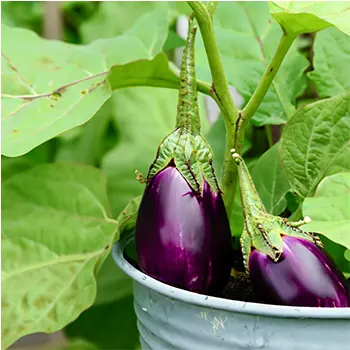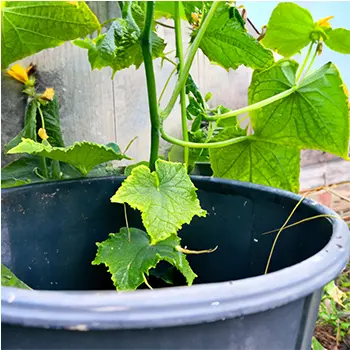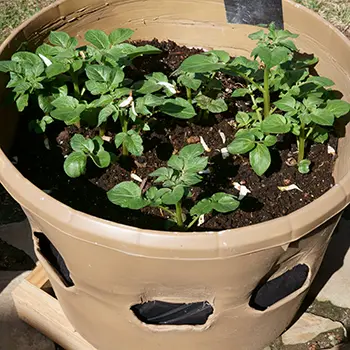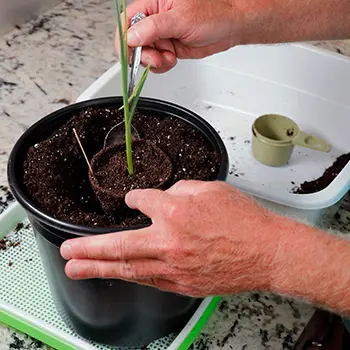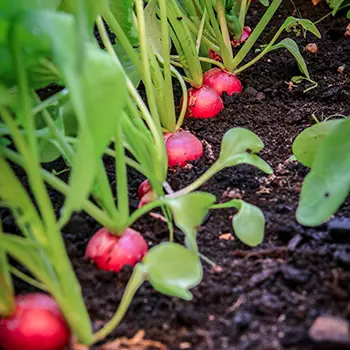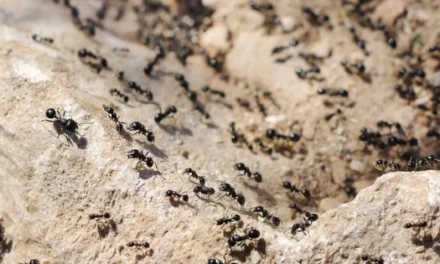You don’t need fields to farm. In fact, there are many of the best crops to grow in buckets that allow you to access fresh farm food no matter where you live.
Container gardening has become popular as urban areas replace farming land with concrete. Even in an apartment, you can still grow healthy fruits and vegetables. In colder climates, where fresh produce is expensive, growing food indoors is a great solution. While a greenhouse might not be an option, all you need is a bucket to start growing fresh food at home.
The Best Crops to Grow in Buckets All Year Round
Many vegetable gardening plants can be grown at home, no matter where you are located. Indoor gardens eliminate the harsh effects of the outdoor climate and allow access to fresh foods.
Creating an indoor container garden or hybrid garden is easy. All it takes is a little effort and knowledge about which plants grow best inside. Below are some plants you can grow indoors and in containers all year round.
Tomatoes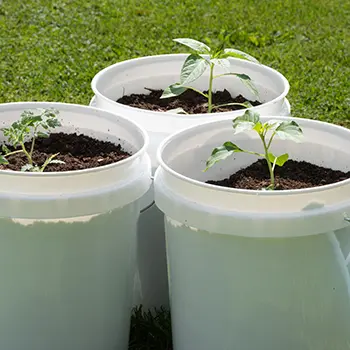
Tomatoes grow surprisingly well indoors. Since most tomato plants must be sprouted inside, keeping them indoors is convenient. Tomatoes can be planted indoors any time of year, especially if you’re focused on extending the growing season.
Best Crops to Grow in Buckets: Kale
Kale thrives in cooler weather, making it the perfect option for cool season container gardening. This plant does well outdoors when planted in early spring and is best planted indoors at the beginning of summer.
Peppers
When placed indoors, peppers can be grown year-round. Planting peppers in a portable bucket allows you to move them around to aid with lower sunlight during winter months.
Related: Why You Should Use Hot Pepper On Your Plants And Vegetables
Best Crops to Grow in Buckets: Arugula
You can grow arugula indoors and enjoy salad greens all year long. This plant needs 10-12 hours of sunlight, should be placed at a south-facing window if possible, and should be planted 3 inches apart.
Eggplant
Eggplant is relatively easy to grow and does well in a container garden. Eggplants are also a plant that continually reproduces, so you get a lot of vegetables in a little space. Since eggplants are tropical plants, you may require a heat lamp or grow light for maintenance.
Herbs
Growing herbs is easy and can save you a lot of money. Fresh herbs are more fragrant and often preferable to dried varieties. Herbs also offer a simplistic introduction to edible gardening for beginners.
You can grow many herbs in containers at home. Basil, chives, mint, oregano, parsley, rosemary, and thyme are the easiest to care for. They also do well when planted indoors.
Best Crops to Grow in Buckets: Onions
Onions are another plant that is relatively easy to grow indoors. Ensuring they have enough space is the most crucial aspect of maintaining this plant. Six inches of depth and three inches between each plant is best. Depending on the type, onions also require 12-16 hours of sunlight daily. Thus, a grow light may help produce an optimal environment.
Green Onions
One of the easiest ways to grow green onions is with a leftover onion. To do this, submerge the roots in a container of water, changing the water weekly. Once the roots reach five inches, you can move the plant to a pot of soil.
Cucumbers
Cucumbers do well indoors in a deep, hanging basket or large container. Provide the plant with at least 8 hours of full sun each day and harvest when the plant reaches 10 inches in height.
Best Crops to Grow in Buckets: Carrots
Outdoor carrots are best harvested in the fall or spring. However, to keep carrots growing year-round, plant them indoors when winter begins and spring is coming to an end.
Lettuce
You can easily grow leaf lettuce at home and access healthy greens anytime. Lettuce can be grown in almost any container as long as there is sufficient drainage. Lettuce is a simple and low-maintenance plant. It needs very little care and can grow in many types of soil. Just keep the soil moist.
Best Crops to Grow in Buckets: Beans
Beans make a great container plant. They take up little space and grow well in most areas. When growing green beans indoors, it is essential to ensure they get a good amount of sun.
Mint
Outside, mint will grow like wildfire, and it smells incredible in the yard. However, you can also grow mint in a container inside your house. Mint needs to receive 4-6 hours of sun per day and has to be shielded from the hot afternoon sunlight.
Mushrooms
Mushrooms are pretty easy to grow. However, they must be placed in a cool, dark, damp space to thrive. Typically a basement, unused cabinet, or closet will work well.
Best Crops to Grow in Buckets: Potatoes
To grow potatoes indoors, cut a sprouted potato into two-inch pieces. Then, plant the pieces in a container with 2.5 gallons of potting mix.
Spinach
Spinach is super healthy and easy enough to grow indoors. Soak and soften the seeds in water. Then, plant them in a container that gets plenty of sunlight. Keep the soil moist. This way, you can enjoy this powerful vegetable all year round.
Peas
Wide varieties of peas grow well indoors, with snap peas and snow peas being the easiest to grow inside. Peas need sunlight, so they should be placed in the sunniest location of the home.
Sprouts and plants also require support. Adding a small stick to each shoot will allow them to climb and grow.
Best Crops to Grow in Buckets: Garlic
A life without garlic is no life at all. Thankfully garlic is easy to grow, and you can do it indoors anytime.
To grow garlic, place 3-4 cloves in a pot of soil and sit it on a sunny window ledge. Water the plant lightly when dry and allow it to flourish.
Cabbage
Cabbage typically grows in the fall and spring. Due to its extended growing time, cabbage does well in various temperatures. When growing cabbage indoors, start the seeds at the end of spring. You can also space out planting to extend the harvest.
Artichoke
Artichokes require more attention than other plants but can thrive in containers with adequate care. The main thing to remember is that good drainage is important. The container must be large enough for the roots. A 5-gallon bucket will work fine for this purpose.
Best Crops to Grow in Buckets: Squash
Another plant that is generally straightforward is squash. When planted in a large container with plenty of sunlight, squash can thrive indoors. It is best to pick a smaller, bush-type squash to save space. However, any type of squash plant will give a good harvest in about 60 days after planting.
Radishes
Radishes have a shallow root system, making them perfect for indoor gardens. This plant also prefers when it is cool, so early spring and mid summer are the best times to plant. Alternatively, place the container in an area that suits the optimal conditions, and you can have radishes all year long.
Celery
You can regrow celery using the base of a used stalk by placing it in a shallow container with water. It takes about a week to see progress, and then you can move the celery to a container filled with soil.
Red Beets
Beets do well in containers but require 6-8 hours of sunlight. Place the container in front of a large, sunny window or purchase a grow light if you live in a dark, northern area.
Best Crops to Grow in Buckets: Microgreens
Growing microgreens is increasingly popular, and many systems on the market make the process simple. The main issue with microgreens is that they often do not regrow.
Due to the micro size, all the energy they hold is used in production, and once trimmed, they must be replanted. Still, they are an excellent food source that can be grown year-round.
Although living on a farm may appeal to you, it is not always possible. However, that does not mean you can’t live a sustainable, self-sufficient lifestyle wherever you are in the world.
You can grow food inside your home to provide sustenance and security. The list above is not comprehensive, and I would love to hear what you grow in containers at home.
This article first appeared here.
You may also like:
Veggies You Only Plant Once And Harvest Forever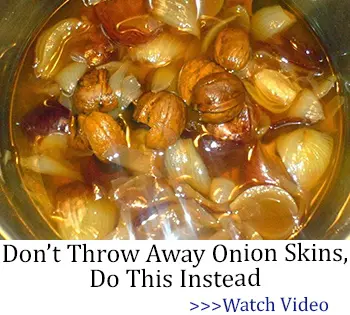
The Only Food That Grows Almost Faster Than You Can Eat It (Video)
Vegetables That Grow Faster Than Grass
Cut Down On Your Bills In 2024 With These Amish Projects


